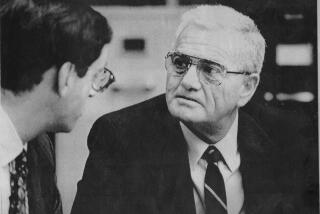Memories Made to Order at UCI
- Share via
With a little ingenuity and the power of suggestion, it really is possible to make people believe the improbable -- that they kissed a frog or shook hands with Bugs Bunny at Disneyland.
The findings are among the latest work on false memories by UC Irvine cognitive psychologist Elizabeth Loftus and her researchers. They were presented Sunday in Denver at the annual meeting of the American Assn. for the Advancement of Science.
Loftus’ work has implications in criminal cases in which childhood memories of supposed sexual abuse and other crimes crop up decades later, and in situations where memory distortion comes into play, such as in the recent sniper attacks around Washington, D.C.
“Give me enough time with somebody, and I’ll make them believe in just about everything,” Loftus said.
If that sounds worrisome, she said it’s better to understand the truth about the human mind “so you know how to defend against it.”
Loftus came to UC Irvine as a professor of psychology and criminology this year after 29 years at the University of Washington in Seattle. She has been an expert witness or consultant in a number of high-profile trials, including the McMartin Preschool molestation case, the Hillside Strangler case, the Rodney King beating and the Bosnian war trials.
Loftus presented the results of three experiments, all involving planting false memories.
In one study, undertaken with one of her researchers, interviewers in Russia were able to convince 12.5% of their subjects that they had seen a wounded animal in media coverage of two terrorist bombings in Moscow that killed 233 people in September 1999.
The people were first interviewed in March 2002. They were interviewed again six months later and told that they had mentioned a wounded animal in their first interview. They were asked to describe it.
One person described a parrot in a cage. Another described a dog barking and racing around police officers. Another talked of a bleeding cat lying on a desk.
One problem: They all made it up. No wounded animals were shown on TV or in newspaper or magazine coverage of the incident.
“There are a lot of studies now of the aftermath of 9/11,” Loftus said. “What are people going to remember? The bottom line is: It shows you can take an event that is very traumatic to people and tamper with it.”
A study of University of Washington students last year illustrated ways in which ideas can be planted in people’s memories. Subjects were asked to study a made-up advertisement describing meeting Bugs Bunny at Disneyland.
People later said that when they had visited the Anaheim amusement park as children, they had shaken hands with Bugs, hugged him and touched his tail. Some even recalled the character uttering his signature “What’s up, doc?”
The percentages varied, depending on the number of times people were exposed to the ad and other factors. In one study, though, 46% of those who claimed to have met Bugs said they shook his hand.
One problem: Since the rascally rabbit is a Warner Bros. character, he would never have been at the Disney attraction.
“Clearly these are impossible memories, and no one can say we revived true memories,” Loftus said.
In another 2002 experiment by Loftus’ doctoral student Ayanna Thomas, University of Washington students were told to imagine the color of a frog, and how it would feel on their lips. Subjects were told to imagine other activities, such as crushing a Hershey’s kiss with a dental floss container. Two weeks later, they were asked to recall what they had done on that previous day.
Fifteen percent claimed they actually had kissed a frog or smashed a chocolate. Though the percentage is not large, Loftus said, it was significant that people were willing to say they did something bizarre and improbable when they did not.
What’s at work, said the memory specialist, is that people are first persuaded a thing is plausible. In the Bugs Bunny experiment, for example, people saw a realistic advertisement.
“People think, ‘If it’s part of an advertisement, it must be true,’ ” she said.
Next, people are asked about their own experiences in such a way as to suggest that the same thing happened to them.
They are asked to imagine how something might smell, look or feel, for example, kissing a frog.
“Then what you have is an experience that feels like a memory,” Loftus said.
Witnesses can be reliable if their recollections are not distorted or contaminated, but the research suggests people can be persuaded to interpret events in new ways.
And it can happen to an entire population, as shown by public reaction to the October sniper shootings that panicked Washington and suburban Virginia and Maryland for three weeks.
“Suddenly, everybody is out there seeing white vans, looking for white vans,” Loftus said. “My suggestion is that because somebody talked about a white van in the media, people became unwitting subjects in some mass memory distortion experiment. In the end, [the pair arrested] had a blue Caprice.”







